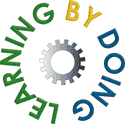What do candidates on the Fixed Equipment Testing training course actually do?
Candidates on the fixed equipment testing course learn about what sort of equipment is not tested as part of the installation or the PAT testing regime. We look at how the law requires these 'forgotten' items to be proved safe. We analyse who should be carrying out the checks, how often they should be done and exactly what they should consist of. It's important that they understand how to safely isolate fixed equipment before taking it apart - this is why the course isn't suitable for non-electrical people. Candidates are given straight forward, clear flowcharts to follow. They then learn about what the visual inspection should consist of and how the electrical tests should be performed. We also look at how the frequency of checks should be determined and the documentation required. Then we get the candidates to perform isolation, inspection and testing on a range of real fixed equipment and they complete records of their results. We finish the course with a multiple-choice assessment paper that checks that they have understood the key teaching points of the day. Candidates are provided with comprehensive course notes.
We begin by talking about the legal requirements and then we look at the sorts of things that will need to be tested. We also try to simplify the whole process (which is often presented in an inordinately complicated way by others) by reducing the isolation and the checking procedures down to two very easy to follow flowcharts. The following are pages from the course notes for this part of the course:
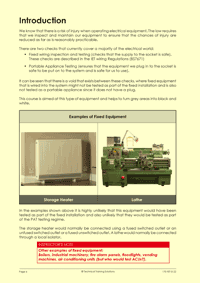 |
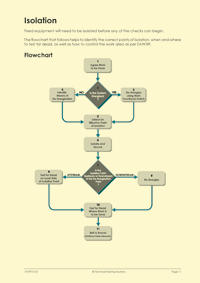 |
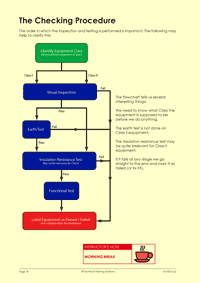 |
Page 6 of the course notes for the fixed equipment testing training course, describing what fixed equipment typically looks like |
Page 11 of the course notes for the fixed equipment testing training course, which guides the candidates through a proper isolation procedure |
Page 18 of the course notes for the fixed equipment testing training course, which guides the candidates through a straight forward checking procedure |
We then look at how the visual inspection should be conducted and the typical things that we need to look for. This will of course vary from one piece of equipment to another and we discuss that. Following on from this we discuss what sort of test equipment can be used for the tests. Then we analyse the tests themselves in detail, thinking about exactly where we need to connect our probes and what sort of results should be achieved. The following are some extracts from the course notes for this part of the course:
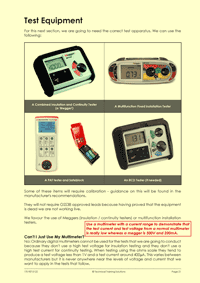 |
 |
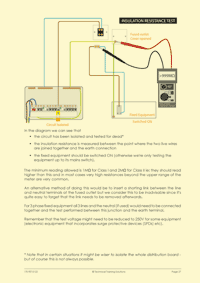 |
Page 21 of the course notes, explaining what sort of test equipment can be used for the tests |
Page 24 of the course notes, which explains how the earth continuity test should be performed |
Page 27 of the course notes, which explains how the insulation resistance test should be performed |
We then proceed to our main focus of the course which is to actually perform the inspection and testing on a range of real equipment. To do this we use two training rigs which incorporate single phase heaters and 3 phase motors. These need to be safely isolated (because they are connected to the supply and therefore potentially live) and the candidates need to show us that they can do this properly. We then proceed to perform the visual inspections and the electrical tests for the equipment selected. Whilst doing this we tend to encounter all the practical difficulties of where to connect the probes, which terminals need to be exposed, etc. The following are the rigs that we use for this part of the course:
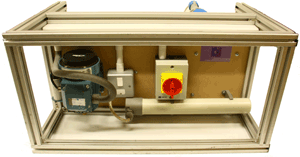 |
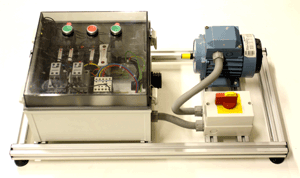 |
The single phase training rig. This is mains powered so the candidates have to safely isolate the heater then open the appropriate covers to get to the necessary terminals. They can then conduct the inspection and testing. |
The three phase training rig. Again this needs to be safely isolated and we can then open the covers required to gain access to the necessary terminals. The required inspection and testing is then performed. |
We also isolate, inspect and test a range of fixed equipment around the building that we are in. On courses here in Rochester we use one of our lathes and a storage heater. On courses held at customers' premises we would select something suitable there (although we wouldn't necessarily be authorised to remove covers from this equipment in that scenario). However at the very least we can talk the candidates through how this should be done and ask them to write it down so that they produce a standard operating procedure for the task.
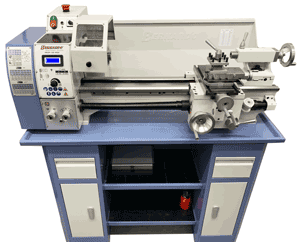 |
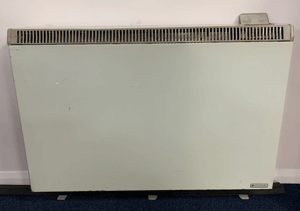 |
Our lathe. We conduct visual inspections, isolate it and then perform all the required tests. |
One of our storage heaters. We perform the necessary isolation, inspection and testing of this too. |
It is of course important that the candidates document their findings and as part of the practical exercises outlined above they have to complete an equipment register, also making a decision about how frequently each particular piece of equipment would need to be checked. The visual inspection is then recorded and we expect the candidates to highlight any dangerous issues found on the equipment. Candidates need to determine which tests are appropriate. The results of the tests are then recorded and a decision made about whether the equipment has passed or failed. We finish by administering a multiple choice question paper which checks to make sure that the candidates have understood all the key teaching points of the day. The following are some extracts from the course notes for this part of the course:
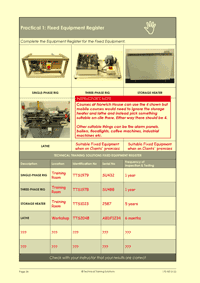 |
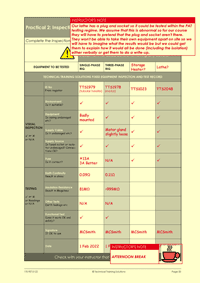 |
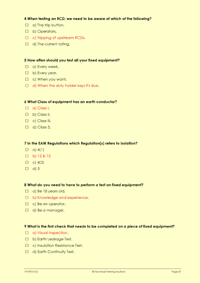 |
Page 34 of the course notes, where the candidates complete an equipment register. |
Page 35 of the course notes, where the candidates complete an inspection and testing record. |
Page 37 of the course notes, showing part of the multiple choice assessment. |
Please note that all the extracts from the course notes shown in the above are taken from the instructor's version of the course notes. The candidates wouldn't have any entries in the registers and records in their version and they certainly wouldn't have the answers to the assessment highlighted like in the one shown above!
If you would like to see some of the equipment used on the Fixed Equipment Testing course for yourself, then please call us to arrange a visit to our offices in Kent. Alternatively, we can visit you anywhere in the British Isles.
